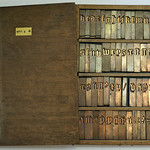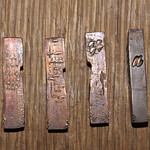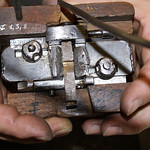My daily work at the Dutch Type Library, as a type designer, font producer, and software developer, provides a solid basis for the development of my insight. Working not only on my own type designs, but also on the typefaces of the various designers who work for my company, is very valuable, as is the study of historical models for the creation of revivals.

Modifications on a home computer (around 1984)
I bought my first (home) computer, an Acorn Electron, in 1983. Naturally, no software was available for this computer to create and edit letterforms. So while I am by no means a programmer, I have written some simple digitization (vector format), modification, and interpolation software in Basic. The program was called ‘DrawMonkey’ and some of the resulting letters (collected photos taken from a computer screen) were shown in the 1987 publication 26 Letters. Since that time I have become increasingly interested in defining and controlling font-production processes.

Two pages from 26 letters designed by Blokland (1987)
Since the late 1990s, I have been involved as an initiator and software architect in the development of dtl FontMaster, a set of batch utilities for professional font production. The following diagram shows the workflow I have defined and built over time (ten years to be precise) for font production at the Dutch Type Library. For this workflow, which is based on dtl’s proprietary software, I wrote the command and script files myself.

FontMaster-based workflow for the font production at DTL
After developing batch software for font production, the next logical step was to explore the automation of type-design processes. The models I have developed over the years have already forced me to parameterize parts of the letter creation process for my students, if only because some digitally trained students see writing with a broad nib and a pointed pen as a remnant of a bygone era (see also Writing and Type). Partly based on this experience, I started investigating the possible standardization of the Renaissance type-production processes.
The development of the LetterModeller (LeMo) application, which can be downloaded from this site, was partly the result of all this. It is primarily a tool for exploring and further developing my theoretical models, but also a tool that can be used for generating (the basic structures for) letters. For my research, I created a monolinear (skeleton) capital font in the ikarus format, whose horizontal proportions are related to the width of the /m of the primary harmonic model, and which can be adjusted using LeMo's parameters.

Concise overview of the two current variants of the ‘Archetype’ font
LeMo was used for the development of the typeface that I developed for my dissertation, called ‘Archetype’. This typeface includes display and text versions, each with variants based on proportions and details applied in the Renaissance and Baroque style periods.




